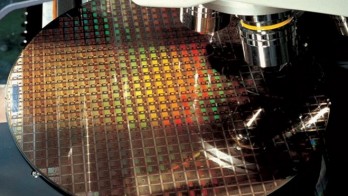For years, analysts have reported on the shadowy negotiations between the world’s largest foundry, TSMC, and Apple as the two companies haggled and discussed the shape of future collaboration. Now, the fruits of that collaboration are finally moving towards the light of day — TSMC has reportedly begun volume shipments of 20nm silicon earmarked for Apple’s next-gen iPhone (and possibly iPad). The new chip, likely codenamed the A8, will be the first flagship part built at TSMC instead of at Samsung, and it’s a major coup for the Taiwanese company to have stolen the business from its Korean rival.
Exactly how much of Apple’s business is shifting to TSMC is still unknown. The A8 will be the first 20nm SoC available on the market; companies like Qualcomm aren’t expected to introduce their own 20nm hardware until 2015. That gap gives Apple first-mover momentum and it’s undoubtedly part of what the company paid for in its agreements with TSMC. It’s possible that this shift could spark other companies to move production to other facilities — companies that compete with Apple at TSMC could conceivably move business to Samsung or GlobalFoundries if they think the Taiwanese foundry won’t be able to keep up with demand.
Such shifts, however, require that the foundries themselves are able to provide the necessary capabilities — and that’s not exactly a given. Rumors from earlier this year have suggested that Qualcomm will shift some 20nm production to GF, but without casting aspersions on the Saratoga-based company, we’ve heard such statements before. Back when 28nm was the new hotness, GF was expected to seize a great deal of volume from TSMC and establish itself as a competitive alternative. That didn’t happen — GlobalFoundries’ ramp has been much slower — and the company has partnered with Samsung for 14nm deployments rather than continue with its own 14nm-XM plans.
We’re guessing that Apple will have a second source for its 20nm hardware, if only to ensure it has adequate supply in the event of a supply chain issue. Samsung is the logical alternative — the two companies may have fought each other tooth and nail in the courts and markets, but they’ve also collaborated for the better part of a decade.
As for the quality of the 20nm production itself, that’s going to be very interesting. Apple could take the A8 in a number of directions, from a relatively straightforward die shrink to a new core to its first quad-core in an iPhone. We expect that the device will combine a 20nm Qualcomm modem with a 20nm processor, which should yield significant performance improvements, and then there are the rumors of sapphire glass use. If true, the iPhone 6 could be a significant step forward from the iPhone 5S of last year.








